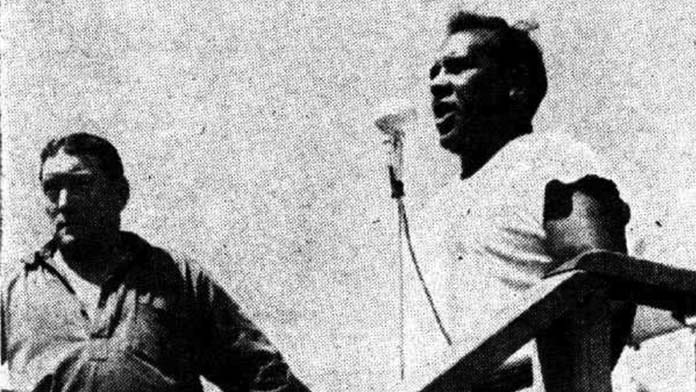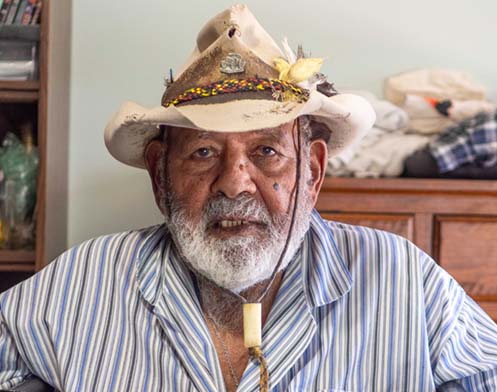Paddy Gibson spoke to Indigenous activist Ray Peckham about the fight against segregation and the Aboriginal Welfare Board, and how trade unions aided the struggle
In early December, 2023, I travelled from Sydney to Dubbo with Gadigal, Bidjigal and Yuin Elder Aunty Rhonda Grovenor-Dixon to interview Ray Peckham, a 94-year-old Wiradjuri man who played a central role in the Aboriginal rights movement in the 1950s and 1960s. We were joined by Suellyn Tighe, a Gomeroi woman from Coonabarabran.
Aunty Rhonda, Suellyn and I are all involved in campaigns against racism and for self-determination and land rights.
We learned some important lessons from Ray, who shared many precious stories and insights from his experience in the struggle.
Ray was a communist and his activism was grounded in the trade union movement.
When he first travelled to Sydney in 1950 at the age of 20, Ray was greeted by veteran Aboriginal activist Pearl Gibbs, who immediately recognised his potential, recruited him to the struggle and took him to Trades Hall to meet with union leaders.
Ray started work as a builders’ labourer and became deeply involved in efforts by the Communist Party of Australia (CPA) to mobilise the support of working-class organisations behind campaigns for Aboriginal rights.
He joined two campaign organisations operating in Sydney, the Australian Aboriginal Fellowship (AAF), which included non-Indigenous activists, and later the Aborigines Progressive Association (APA).
For two decades, Ray fought against the system of apartheid that operated in NSW and across Australia. The NSW Aboriginal Welfare Board (AWB) exercised dictatorial powers. Aboriginal people were kept in horrific poverty on the fringes of country towns and excluded from many shops and services.
Ray travelled across NSW organising Aboriginal communities to fight for their rights.
He also worked tirelessly to campaign in workplaces and trade union meetings, appealing to non-Indigenous workers to take a stand against racism and use the power of the trade union movement to seriously contest the draconian AWB.
Central to Ray’s political outlook was an analysis that Aboriginal people and non-Indigenous workers shared a common struggle against a capitalist system based on exploitation, war and racism. It was the common experiences of exploitation that created opportunities to use the collective power of trade union organisation to fight back:
“We were all working class people. Black and white, New Australians, it didn’t matter who you were, you were a union member. It’s that unity that gave us power.”
Ray got a taste of union power very early in his activist career. In 1951 he was invited to attend a Peace conference in East Germany, within the Soviet Bloc.
Ray was on board a vessel ready to sail from Melbourne, when they received word that the AWB was not going to let him travel and had stopped the government issuing him a passport, “they reckoned they were saving my life, protecting me from communism”.
The Peace Festival delegation, however, had the endorsement of a range of trade unions, who now mobilised to fight this racist restriction on the right to travel.
“The weight of the trade union movement said that if Ray Peckham doesn’t sail on this ship, we will tie up all the ports of Australia, nothing will move. For four hours we held up that ship, it cost them a lot of money too.”
This threat of widespread union action to stop commercial shipping forced the AWB to back down. A passport was hastily prepared and rushed to the ship so Ray could sail.
Union power against the Aborigines Welfare Board
Over the course of the next two decades, Ray worked to bring union power to bear against the AWB at strategic times, eventually breaking their system of racist controls. One campaign Ray argues was of crucial significance was a fight in 1960-61 led by Dunghutti man Horace Saunders, from the Purfleet Aboriginal Reserve at Taree.
The residents of Purfleet were refusing to pay rent to the AWB, protesting about the shocking conditions on their reserve. Houses had no running water, electricity or proper drainage.
“There were no bathrooms then. No toilets. No cooking facilities, you did all your cooking on a fire in the yard. Babies were dying from diphtheria and that sort of thing, caused by torrential rain flooding the pit toilets.”
One of the babies that died was a child of Saunders. In response to the strike, the AWB moved to evict Saunders and his family for non-payment of rent. Saunders was targeted “because he was the only man on the reserve at the time who had collateral”, owning two boats and other equipment from his commercial fishing business.
Ray explained that “they wanted to make a holy show of him, so instead of just taking him to the local magistrates court in Taree, they took him to the Supreme Court”.
Both the AAF and the APA supported Ray to travel to Taree, spend time with Saunders and help plan a fight back: “I said, the best thing you can do is come to Sydney with me, I’ll introduce you to the Trades and Labour Council and we will get the weight of the Trade Unions behind us.”
More than 20 trade unions participated in solidarity activities when Saunders visited Sydney in February 1961. A large delegation organised by the NSW Labour Council accompanied Saunders to see the Chief Secretary of the Aborigines Welfare Board and demand the case be withdrawn.
The CPA’s newspaper Tribune reported at the time that “wide trade union and public support in the Purfleet eviction case has lifted it from a housing struggle to a struggle for equal rights for the whole Aboriginal people”.
Union resolutions backing Saunders also called for the abolition of the discriminatory powers wielded by the AWB.
Saunders and Peckham campaigned for weeks visiting unionised workplaces, speaking to lunch-time meetings about the case and winning donations and resolutions of support.
“I went on a tour of all the mines, travelling to Wollongong and Lithgow. Horry stayed with the Builders’ Labourers in Sydney.”
In an article in the Tribune in 1961, Ray said:
“At every meeting, I was given a very enthusiastic reception. The white workers’ moral and financial support for the struggles of Aboriginal people are becoming a source of strength and courage which my people are coming to appreciate more and more.
“At the Coalcliff pit, the miners were actually meeting to hear a report on the strike at Nebo pit, but they deliberately delayed the vote on whether they would strike in sympathy to be sure I had an undivided hearing. They pledged full support for our campaign and decided on a 5/- levy per man to assist.”
When the case was heard in the Supreme Court, Saunders was represented by Fred Patterson, a barrister and veteran CPA member. In a huge blow to the authority of the AWB, Saunders won the case, and the AWB was forced to compensate him for nine weeks of lost earnings.
According to Ray, this was the beginning of the end for the AWB, “they didn’t last ten years after that. We showed they could be beaten and they were on the their way to being abolished”.
Breaking segregation
The success at Taree encouraged growing efforts to self-organise against appalling conditions in Aboriginal communities across NSW.
Throughout the early 1960s, the Tribune was regularly reporting on protests that led to the construction of new houses right across the state, from Moree, to Coonamble, Armidale, Nambucca Heads and down the South Coast.
In all these communities, the fight for better living conditions went hand in hand with demands against racial segregation. A visit by Peckham in 1962 helped residents of Moree successfully build pressure for new houses and win a declaration from the Health Minister that there could be “no racial or colour segregation of patients in Moree or other NSW State hospitals”.
Ray talked with us about a campaign at Port Kembla in this period to illustrate the crucial role of unions. Residents of the Coomaditchie Aboriginal reserve were demanding new houses, but some of the only remaining land in the area was being taken over by the adjacent University.
“Bobby Davis [a local Aboriginal leader] was a wharfie at Port Kembla and he worked with Joe Howe, a delegate from the Waterside Workers Federation.
“They set up a campaign, naturally it was through the Trades and Labour Council and backed by the union. They won that strip of land and had eight houses built on it from that fight.”
In Sydney and Wollongong too, union power was used to fight segregation. Pubs that refused to serve Aboriginal people would be confronted by crowds of trade unionists. Ray explained, “We would get the Liquor Trades Union to put a ban on the pub. Force them to change that way, with a black ban.”
By the mid-1960s, the ranks of leading Aboriginal trade unionists had grown substantially and played a crucial role in the broader struggle.
Many unions were affiliated to the Federal Council for the Advancement of Aborigines and Torres Strait Islanders (FCAATSI), which held annual conferences of hundreds of people and had a powerful trade union sub-committee convened by Peckham. This group issued a regular bulletin, The Aboriginal Worker.
The Waterside Workers Federation in Sydney had a committee of Aboriginal members that sent six delegates to the 1965 FCAATSI conference, including Rhonda’s father Chicka Dixon, who would come to play a crucial role in the Black Power movement.
That same year, in response to the jailing and forced removal of two Aboriginal children from Walgett for stealing some toys, Peckham led a delegation of 20 Aboriginal trade unionists from Sydney to visit and rally in support of community demands against racism.
Campaigning by FCAATSI, with the strong support of unions, led to a successful Yes vote in the 1967 referendum, which shifted constitutional responsibility for Aboriginal Affairs from the state to federal governments. Just two years later, the AWB was abolished for good.
Ray emphasises, however, that it was the fight at the grassroots, with community protests backed by the trade unions, that really broke the power of the board:
“The unions were like our boondi or nulla nulla [fighting stick]. That’s what we need back today, for the young people to understand that we are all working-class people, we have power in the union to fight the system.”







